Can You Drive On A Flat Tire, How Far Can You Drive & Is It Illegal?
Flat tires happen. They can happen at any moment in any location. They can be caused by a nail, screw, sharp rock or a multitude of other hazards on the road. No matter how the flat tire happens, it is nearly always a major inconvenience. So, the question is, “Can you drive on a flat tire?” If your flat happens in the middle of the highway, driving on it so that you are safe is smart, but going any further will be damaging to the wheel and increase the probability of a road accident. Read on to learn a little more about the dangers of driving on a flat tire.

Can You Drive On A Flat Tire?
The simple answer is no. Although, as mentioned above, drive so that you are not in traffic to the side of the road. Driving on a flat tire can put you and your passengers’ safety at risk, as well as damage your vehicle. When you attempt to drive on a flat tire, you’ll notice that your vehicle will not handle appropriately, and you may cause structural damage. The wheel, brakes, and alignment could be ruined as well as your suspension and steering systems. If you attempt to drive on a flat tire, you could be paying for more than just a flat tire fix.
What To Do If You Have A Flat Tire
The first thing you need to do when you have a flat tire is to get somewhere safe that isn’t too far away. The side of the road is fine.
Now that you are safe, you have a few options to choose from. You could change the tire yourself if you have a spare. Or you can use an emergency sealant if the tire does not have a large hole, is not shredded, or completely blown out. The sealant is usually only good for punctures that are ¼ inch or less.
If neither of these options is feasible, it might be time to call for a tow and determine if you need a simple repair or a complete replacement of your flat tire.

Preventing A Flat Tire
Sometimes, there is just no avoiding a nail, screw or sharp object on the highway while going 55 miles per hour. However, there are some preventative measures you can take to minimize the chances of a blow-out or flat tire.
Monthly Tire Pressure Checks
The National Highway Traffic Safety Administrations (NHTSA) recommends checking the tire pressure on your vehicle every month. This includes the spare tire. It’s important to check the tires when they are considered “cold”. This means first thing in the morning or three hours after it has been driven. Low tires can contribute to lower fuel efficiency, and they are more prone to damage.
Visually checking your tires can be misleading, as some tires can lose up to 50% of their pressure before they appear flat. Although some vehicles come with a Tire Pressure Monitoring System (TPMS) it may not warn you until the pressure is significantly lower. You want to catch the pressure loss as soon as possible.
Refer to your owner’s manual for their recommended tire pressure. Using a pressure gauge, check each tire every month to ensure that each tire is at the appropriate level.
Regular Tire Rotation and Inspection
Rotating your tires on a regular basis helps spread out the wear and tear on the tires. This helps them last longer. Tire rotations should take place every 5 to 10 thousand miles. A good way to remember to do this is to have your tires rotated every time you get your oil changed.
As a general rule, tires should have a 3/32” tread depth to be considered safe. Some states or manufacturers may require even less tread depth. Owners should consider visually checking their tires every month when doing tire pressure checks. Your tires should not have any cracking, bubbles, or bulging sidewalls. It’s also a good idea to understand When to Change Tires on your vehicle.
Pay Attention To Tire Load Limit
Each tire not only comes with a recommended pressure, but also with a maximum pressure and maximum load rating on the sidewall of the tire. Take note of the maximum load rating and do not go over that. (help learning How to Read Tires) If you are hauling items in your vehicle over the normal passenger(s) be sure to adjust your tire pressure without going over the maximum. Larger loads put more stress on the tires and if overloaded can cause a tire blowout.
Be Aware Of Road Hazards
From nails to potholes, glass, and everything in between, the roadways are littered with possible road hazards. Always be aware of your surroundings when driving, even looking at the roadway ahead of you for possible hazards. Large debris and potholes may not puncture your tire, but can cause damage to your wheels, rims, and alignment.
It is hard to avoid some hazards. Seeing a nail or screw in the highway going 55 MPH is a bit difficult. However, if you know the road you will be traveling has construction happening, consider taking an alternate route that will have less potential for hazards on the road. If you are consistently having flat tires, the problem may be the tire itself instead of the road.
Consider Run-Flat Tires On Your Vehicle
No matter how many ways you try to prevent them, flat tires happen. It is literally impossible to see every single road hazard before your tire hits it. To be truly safeguarded against flat tires happening at the worst time, consider installing run-flat tires on your vehicle.
Run-flats, like those sold by Dan The Tire Man, are just that. With a sudden loss of tire pressure, the tires are self-supported with reinforced sidewalls that can drive up to 50 miles at 50 miles per hour. Run-flat tires give you peace of mind that you and your family will be safe from a dangerous situation should a flat tire happen.
Is Driving On A Flat Tire Safe?
A lot can happen that causes a flat tire. Hazard in the roadway, deteriorating tires and dangerously low pressure are just a few. Unless you have run-flat tires on your vehicle, it is best to just move your vehicle off the roadway and assess the damage to your tire(s). Driving on a flat tire can cause more damage, equaling more money than just fixing a flat. Be safe.





